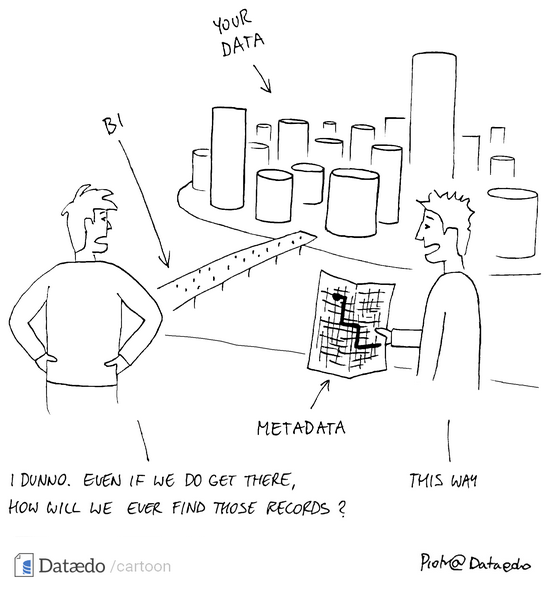
When it comes to business intelligence projects, success is measured in speed. The quicker you can get actionable insights from your analysts and decision-makers, the more likely they turn that information into value for your organization. In the world of data warehousing, that means using a metadata architecture to create a working dimensional model and dataflows to populate the data warehouse.
To adopt a truly agile approach, enterprises must move away from the serialized handoffs between business users, developers, and architects that constitute traditional data warehouse development. Instead, a collaborative process of incorporating metadata in a data warehouse must be adopted in short iterative cycles, so that constant output can be delivered to waiting stakeholders. Therefore, this blog explains what is metadata architecture, the benefits of metadata and why you should build your own data warehouse.
Astera DW Builder (ADWB) is an end-to-end solution that perfectly supports this kind of accelerated data warehouse development. Our product empowers users to configure and deploy a comprehensive dimensional model enriched with technical and business-level metadata in just days.
What is Metadata Architecture?
Metadata architecture focuses on metadata management. However, many enterprises are being forced to re-build their decision support systems as their current systems have flawed architectures. The architecture of a metadata repository plays an important role in the effectiveness of decision support systems. Therefore, it takes time to build the architecture for a metadata repository that will meet all the metadata needs of an organization.
A metadata repository stores and manages business knowledge. Due to the challenges associated with sharing and administering metadata, several metadata repository architectures have emerged. The three most common metadata architectural approaches are:
- Centralized Metadata Management
- Distributed Metadata Management
- Hybrid Centralized
Why Choose A Metadata-Driven Architecture Approach?

dataedo.com/cartoon/we-have-data-now-what
A metadata architecture is the beating heart of any effective BI implementation. It provides vital context for various elements of your data warehouse, including structural information about the entity relationships and data formats that make up the architecture of the EDW. Metadata also shows broader business details such as the processes and definitions associated with a particular set of data.
Whether you’re investigating which source system a particular set of figures in your report came from, figuring out how frequently a dimension is updated, or auditing the business rules that were used to validate a new input – a metadata architecture can help you understand the data you’re working with and thus make far more effective business decisions.
Benefits of Metadata Architecture Approach
- Gain full visibility of the processes and operations that deliver your enterprise data to the data warehouse.
- Empower data users to manage and control their own data without going into the code itself.
- Make data more accessible to enterprise-wide users.
- Allow users to quickly update and modify deployed data models according to current BI requirements.
- Reduce data redundancy and ensure that only relevant data is present in your data warehouse.
Build Your Data Warehouse in Days at the Logical Level

Astera DW Builder takes data warehouse development away from the world of complex ETL scripting and into the world of logical design. Our unified platform allows you to visualize and manage all of the metadata architecture elements that make up your source systems, dimensional models, and dataflows without writing any code.
The result is a fast, agile approach to data warehouse development that puts the control in data owners’ hands and minimizes handoffs to IT teams.
Take Charge of Data Warehouse Design

Through the data model interface you can reverse engineer comprehensive data models from any cloud or on-premise database, and then visualize the data structures that drive operational and reporting processes across your enterprise.
The data model shows:
- How disparate entities within an underlying physical database are connected.
- The naming conventions and descriptions are used to define each entity.
- Entity attributes and their data types.
Once you’re satisfied with your data model structure, you can start configuring its metadata elements to build a schema that serves your business requirements. Whether you’re looking to maintain a normalized ER model or a complete star schema with defined dimension and fact table entities and SCD-handling for specific attributes – you can leverage a full range of code-free functionalities to design your data warehouse.
Generate Complete Source to Data Warehouse Mapping

Astera DW Builder leverages a robust data integration platform to facilitate quick data mapping from your source systems to the data warehouse. With schemas set up, you can quickly begin creating dataflows using the same metadata-driven ETL approach.
Within the dataflow module, you’ll find a variety of drag & drop objects to guide the loading process for your data warehouse. These include:
- Out-of-the-box connectors for an array of applications and databases including leading cloud service providers such as Microsoft Azure and Amazon. You can also connect directly to a data model or use an SQL query to retrieve specific tables from your source database.
- A full toolset of transformations including joins, filters, name & address parsing, and a custom expression builder.
- Data quality tools that allow you to cleanse and validate your source system data.
- Fact and dimension loaders to accelerate data population in a dimensional model.
Again, you will only need to interact with these elements at the logical level. Astera Data Warehouse Builder gives you the full capability to configure table column names, contained data types and values, and the prescribed layout for destination tables to facilitate data mapping.
Deploy and Redeploy Data Models in Minutes

Astera DW Builder is built to support iterative development. Once you’ve got your data models set up, you can verify and deploy them in a few clicks. But it’s also just as easy to integrate new sources and requirements into your architecture. If you depend on your IT team to guide these efforts, then you’re going to be waiting a long time for developers to go into the code to update and test ETL scripts piece by piece.
With Astera DW Builder, you can add new entities or edit existing entities in the data model. Create the necessary data mapping to bring them to the data warehouse in the dataflow module. Then make the new data available for consumption by simply redeploying the data model.
We offer built-in cloud integration features that will help you deploy your data warehouse in the cloud with just a few clicks. Whether you’re looking to get your BI set up in Azure Synapse or Snowflake, we can help you make the transition with ease.
Go Agile with Astera Data Warehouse Builder
We’re ready to help you automate and accelerate every step in your data warehouse development process. For a full look at our features and functionalities, contact us and find out the value we can bring to your BI project. Want to read more? Check out this extensive breakdown of our metadata architecture here.
Authors:
 Adnan Sami Khan
Adnan Sami Khan





 March 27th, 2025
March 27th, 2025 







